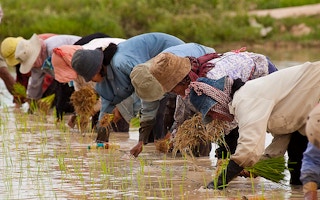In Asia, over 450 million smallholder farmers support the bulk of food supplies. Despite their small land size, they produce up to 80 per cent of the food consumed in the region.
But these farmers currently face a double crisis: climate change and the Covid-19 pandemic.
“One of the impacts of the pandemic is that it has sharpened our focus on the priority areas that have long been of importance to agriculture in Asia. The key to protecting our food supplies lies in protecting our farmers,” said Chris Argent, head of business sustainability, Asia Pacific, at international agribusiness Syngenta.
Speaking at a webinar entitled Agriculture’s Brave New World: Empowering Asia’s farmers in an era of Climate Change, he said that on top of erratic rainfall patterns and increasing temperatures, the pandemic has deepened existing challenges that smallholder farmers face in accessing finance.

Industry leaders speaking at a webinar entitled Agriculture’s Brave New World: Empowering Asia’s farmers in an era of Climate Change.
“Banks are taking a more cautious approach to loans during the pandemic. In India, lending to the agricultural sector has contracted by 1.8 per cent during the pandemic, forcing farmers to turn towards informal private money lenders who can often exploit the situation by charging interest rates as high as 60 per cent,” he added.
But at the same time, the pandemic has also highlighted the importance of food security, which in turn has played a positive role for farmers in the Philippines, said Cherrie Atilano, founding farmer and president of Agrea, an agriculture company that supports Filipino farmers.
“The pandemic has changed how the government responds to farmers. Despite all the challenges that the agriculture sector faced, it contributed positively to our GDP, from negative 0.5 per cent to a positive 1.6 per cent,” Atilano said.
As a result, the agriculture sector is finally seen as a priority and has been allocated a bigger fiscal budget. The pandemic also brought together stronger partnerships between public and private actors for agriculture, she added.
“
“Farmers are innovators, they will come up with ideas as much as scientists can.”
Mark Shepherd, principal scientist, AgResearch
Technology and innovation
To support farmers against the threats of climate change, the speakers agreed that technological innovation and smart agriculture techniques will be among the biggest drivers. But at the same time, these advances cannot be standalone solutions to the climate crisis.
“There are no silver bullets. It will be a gradual uptake of various technologies, and that together will gain momentum and improve things,” commented Mark Shepherd, principal scientist at AgResearch, a New Zealand research agency.
Many digital technologies have been developed on larger farms, but they have benefits on smaller farms too, he added.
“For the small farms, they still need to demonstrate that the technologies deliver results. But when they do deliver, the volumes of data that we collect can aid decision-making and improve the efficiency of their systems,” he said.
Citing the example of animal breeding in New Zealand, Shepherd mentioned that with increased data collection, scientists are now able to measure the methane emissions of cows and sheep to establish breeding programmes for low-emitting animals.
But at the same time, agriculture has lacked funding for the type of research and technologies needed as the sector gets overlooked in the climate change debates, said Paul Nicholson, vice president of Olam International.
“Further investment in research is critical to advance the changes that we need in the agriculture sector,” he added.
Can smallholder farmers achieve scale?
One of the key issues that agribusinesses face is figuring out how to create change at scale, especially with smallholder farmers, said Argent.
“A key question is: how do we encourage sustainable adoption of innovations?” Argent asked.
“I think it starts with confidence in terms of financing solutions for smallholder farmers. There needs to be trust that changing farm practices and adopting new approaches at the smallholder level will still deliver value,” he suggested.
Although digital platforms and technological innovations are mushrooming, at the end of the day there needs to be a parallel intervention on brick and mortar infrastructure, said Atilano.
“Our first step is to work with the government to consolidate smallholder farmers. Most of the time, it’s easier for a group of farmers to borrow from a bank, and get additional support from government or private institutions,” she added.
“No one is working on consolidating farmers and many cooperatives are failing. These cooperatives need assistance in management and governance first,” she said.
To enable change with farmers, empowering them with knowledge is an important step of the process, said Shepherd.
“Farmers are innovators, they will come up with ideas as much as scientists can. My experience is giving them the scientific principles behind the changes that we want to see, coupled with support and infrastructure will enable them to make change,” he added.
Uplifting women and youths in agriculture
Although 40 per cent of the labour force in smallholder farmers are women, they experience disproportionate impacts and face legal barriers within the agriculture sector.
For example, many women do not own land titles and are not involved in the decision-making process, said Atilano.
To work around that, the first step is identifying the roles that women play in agriculture, on and off the farm. While women might not own the land, they often control the household income and decide how to spend the money.
“We analyse what their priorities and preferences are for spending their money. We also offer money mentoring programmes, so that they learn how to grow their money as a business,” Atilano added.
For youths, many of them practice sustainable agriculture as they search for a sense of purpose on top of profits, observed Atilano.
Youths are also interested in technological innovations and improving farming practices. Atilano found that the young professionals who lost their jobs during the pandemic decided to return to their parents’ farms and help them grow their businesses.
“It’s interesting because before, many farmers would tell their children not to follow in their footsteps and be doctors and engineers. But now, young people want to go back to the countryside and help their parents on the farms,” she said.















